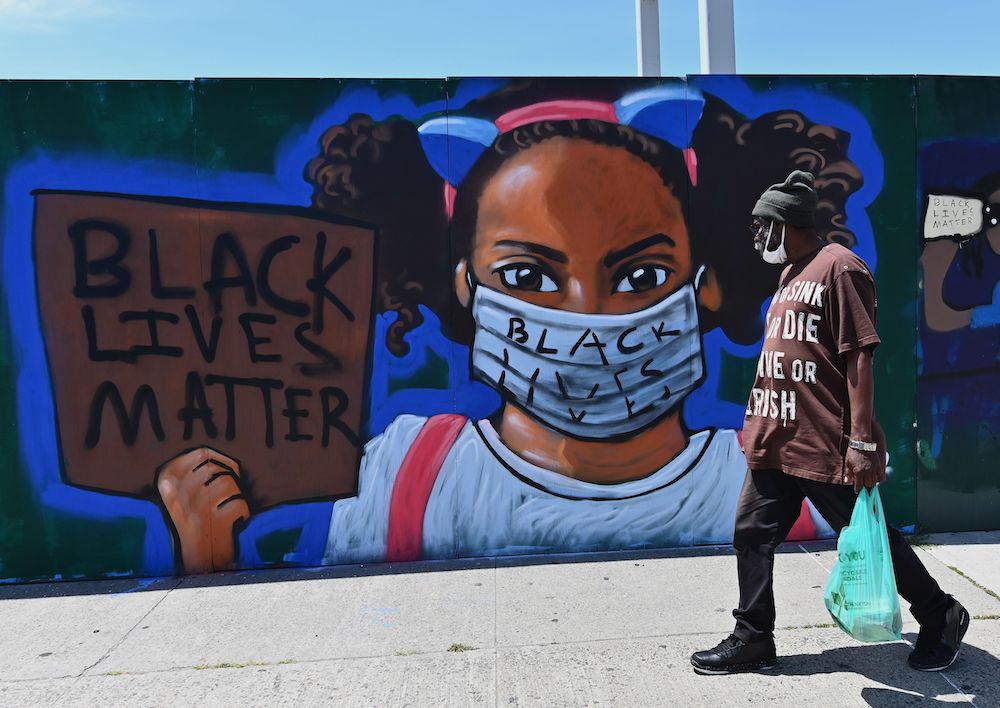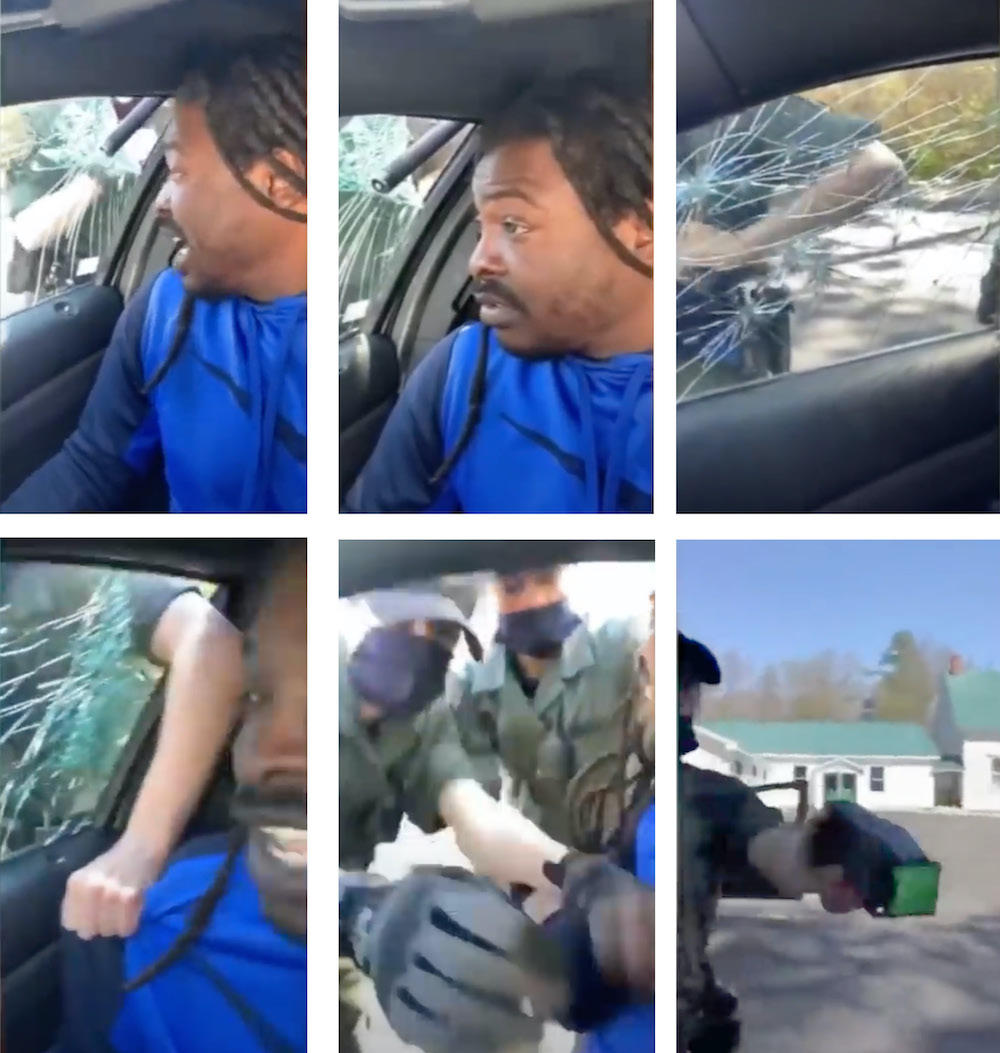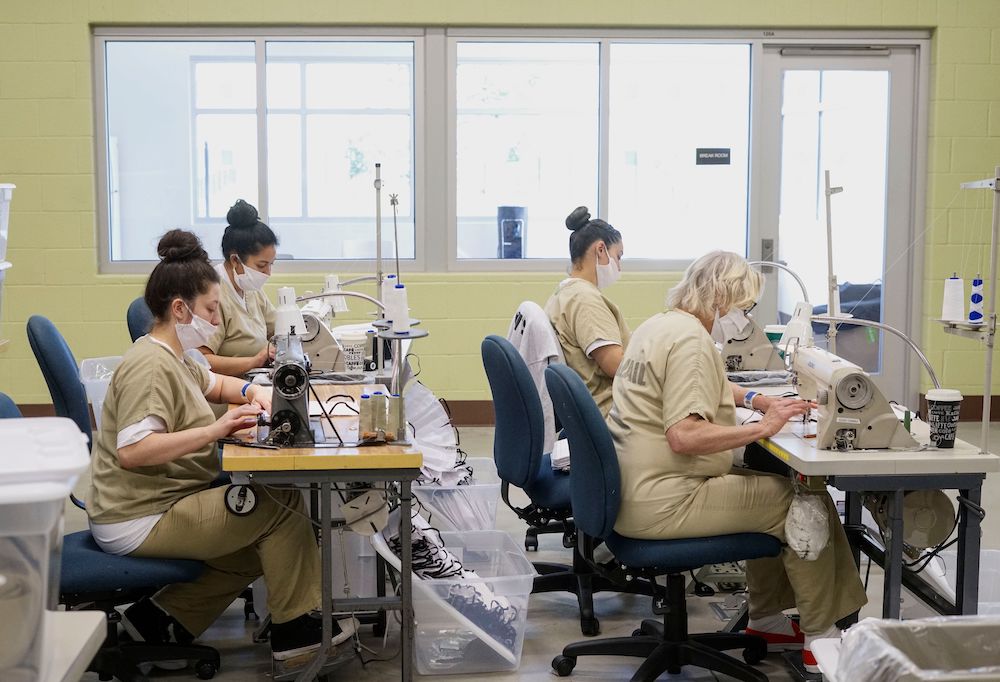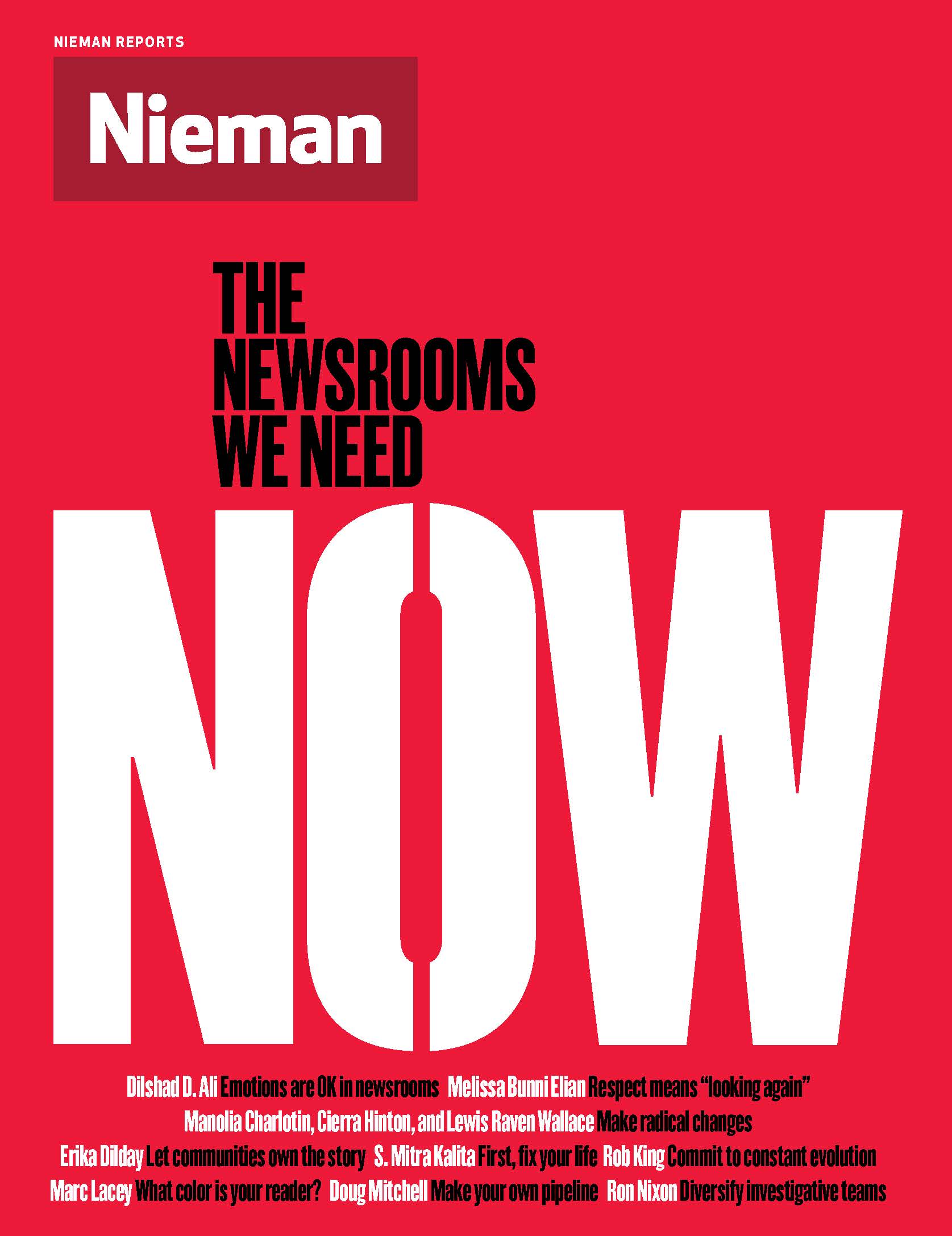
A person walks past a street mural by artist Lexi Bella on June 16, 2020 in the Brooklyn Borough of New York City
On a clear day, May 20th, in the parking lot of the town hall of Albany, a 700-person town in New Hampshire, two state troopers pulled over Saint Preux, a 34-year-old Black man, for an alleged motor vehicle inspection sticker violation. Allegedly without asking for his license or registration — the police claim otherwise — they demanded he get out of the car. When he refused for several minutes, the police said he was under arrest and broke in.

Jean Ronald Saint Preux captured the moment police smashed his window while livestreaming on Facebook
One officer wedged her baton into a corner of the car’s cracked window, while the other pounded the glass with the cap of a baton until it cracked into a giant spider web. The second officer peeled back the pane with a rolling crunch. The car door opened. They grabbed Saint Preux by head, hair, and ears, dragged him out of the car, and tased him.
The video went viral, drawing over 300,000 views when local newspaper The Conway Daily Sun picked up the story on May 28. “I just felt like I was going to be another statistic,” Saint Preux said in an interview with Freedom Media Canada, an independent media organization that focuses on police accountability. “One of them people that gets killed for no reason.” Saint Preux was charged with assault on a police officer, resisting arrest, disobeying a police officer, and a motor vehicle inspection sticker violation.
At the time, the Granite State News Collaborative (GSNC), a collective of 17 newsrooms across New Hampshire, of which the Sun is a member, was only sharing Covid-19 stories. But as the Black Lives Matter movement began to convulse the country following George Floyd’s killing on May 25, just five days after Saint Preux’s incident, expanding the collaborative to encompass the next crisis was a given, says Melanie Plenda, the director of the GSNC. Plenda alerted the partners to Saint Preux’s story. On May 29th, New Hampshire Public Radio picked it up, with a reporter directly asking the governor about the incident at a Covid-19 press conference.
“It was a story that probably would’ve lived and died in a small town,” says Plenda. “But within a day because we all worked together and furthered the reporting, at the least the governor went on record for saying he’d look into it.”
As the world swings from one crisis to the next, such is the indispensable nature of collaboration at this moment for journalism. Just as the coronavirus pandemic and the Black Lives Matter protests have laid bare America’s devastating social vulnerabilities and inequities, so too has it highlighted the media’s own weaknesses — scarcity of resources, inability to do in-person reporting, shrinking budgets, especially for local media. While this is still a time of a high-stakes competition among news outlets, it’s also a time of high-reward collaboration. To meet the mounting challenges from mounting crises a historically competitive media culture is giving way to an accelerating trend of collaboration.
Collaboration “is a necessity,” says Plenda. “News outlets really feel compelled to get this information out to their communities. That was the most important thing [for GSNC].”
As the world swings from one crisis to the next, such is the indispensable nature of collab- oration at this moment for journalism
To be sure, collaboration is not a new phenomenon in journalism. By 1846, the invention of the telegraph had so dramatically upended the media that five New York papers banded together to create the Associated Press to reduce the costs and competition of covering the Mexican-American War. Starting in the 2000s, collaborations gathered momentum, with money pouring into initiatives from the Knight Foundation, the Democracy Fund, and the Corporation for Public Broadcasting. In 2016, ProPublica partnered with a coalition of organizations, including the USA Today News Network, to launch Electionland, an initiative covering voting issues. The International Consortium of Investigative Journalists’ analysis of the leaked Panama Papers that same year — an effort of over 100 news outlets in 25 languages — was a watershed moment.
But in just the last few years, the number and diversity of collaborations has exploded. According to the Center for Cooperative Media at Montclair State University, which houses a database of collaborative journalism projects, U.S. collaborations have grown from 44 in 2017 to over 300 today.
It’s not just the act of collaboration that’s growing, but the tools and resources created to facilitate it, too. Resolve Philly, which has launched several newsroom initiatives over the years covering different areas in Philadelphia, recently won a $1 million grant to launch a new one called Equally Informed, a public service campaign to ensure Philadelphians have access to Covid-19-related info in English, Spanish, Mandarin, Vietnamese, and French. Oklahoma Watch, a collaboration for investigative journalism in the state, launched the Coronavirus Storytelling Project to help displaced or furloughed journalists or newsrooms struggling through the pandemic. Loved and Lost is a New Jersey-statewide collaboration aiming to write obituaries — or, as the project calls them, celebrations — for the lives of the over 15,000 residents lost to Covid-19. The list goes on.
“For the survival of journalism, we have to find new ways to collaborate,” says Kat Stafford, a reporter with the Associated Press covering race and ethnicity. “We are trying to serve the reader, the communities … it’s so vital to make sure that local journalists are able to provide a level of nuance for their readers. [Collaboration] is the future of journalism.”
When the pandemic hit, Stafford knew immediately one community that needed to be served: African-Americans. From the Great Depression to Hurricane Katrina, African-Americans disproportionately suffer during major disasters. The pandemic would be no different. Stafford could already see it happening in her hometown of Detroit. Entire generations of families, gone; denied hospital visits, some died at home. “The magnitude of the deaths has been unreal,” says Stafford. “I knew that this was something we needed to look at right away.”
So Stafford and a team of eight reporters across the country started to dig. They called every state for a breakdown of Covid-19 deaths by race. With so many hands in a single project and different streams of data, reporting such a sweeping and technical story can be tricky. To keep everything in check, they used AP’s DataKit, an open-source interface tool designed to provide structure to vast newsroom collaborations.
Since its public launch in September 2019, DataKit has served as the backbone for every data analysis reporting project at the AP. With collaborations, reporters often come with different ways of working and data coming in from many places — FOIA requests, emails, spreadsheets, RSS scrapers. With DataKit, everything is consolidated into one place. It allows data to sync, reporters to work on the same project simultaneously, dialogue between teams, and opportunities to build out stories from data. “On any given project … it takes something that could take an hour, and shave it down into seconds, literally,” says Troy Thibodeaux, data journalism team editor at the Associated Press.
What emerged was a dire portrait, and one of the first nationwide looks at Covid-19’s disproportionate impact on African-Americans. While African-Americans represent 14% of the population in analyzed areas, they represent nearly a third of known Covid-19 deaths. Obtaining the data was not easy. Some states, like Pennsylvania, were not releasing the data, claiming to either be too overwhelmed or not having it at all. Overlooking demographics like that, “Frankly,” says Stafford, “was part of the story.”
Ultimately, the AP data got local leaders and politicians talking about systemic racism and structural inequality, all the way up to Joe Biden, the former vice president and presumptive Democratic presidential nominee, who cited AP’s data in a tweet, calling the health inequities “unconscionable.” As a cascade of similar reports followed, along with many lawmakers joining the chorus to release demographic data, the CDC finally released its first breakdown of Covid-19 case data by race. While federal data was missing racial information for 75% of all cases, the known data showed that 30% of patients whose race was known were Black.
“Our ability to do one of the first comprehensive looks at the racial toll really set the tone in the conversation for how Americans should be viewing this pandemic,” says Stafford.
The use of DataKit is not just limited to AP. DataKit “is a living project, open source, and free. I would really love to see if other newsrooms … make it their own,” says Thibodeaux.
DataKit is just one of many tools AP has designed. There’s also the “Chronomancer,” a data-pulling tool that predates Covid-19 but has since been informally called the “Coronamancer.” The tool pulls data from Johns Hopkins data every hour, adds a few more layers of information like population counts and 7-day rolling averages, and then publishes it live, one of more than a dozen Covid-19 datasets that local reporters can use in their reporting.
AP also generates graphs for weekly news like unemployment claim filings. Within AP, there’s COVID Hub, a standalone internal website that provides AP reporters regularly updated dashboards on national and state-level figures on a number of metrics, from testing rates to 14-day case trends. “Everything we do is collaboration,” says Meghan Hoyer, the lead data editor on the racial toll story. At a time when data is so scattered and changing all of the time, these tools mean they can answer the basic questions a lot faster.

Inmates sew protective masks at Las Colinas Women's Detention Facility in Santee, California, on April 22, 2020. The Marshall Project partnered with the Associated Press to track coronavirus cases in prisons
One of those public data sets is published alongside The Marshall Project, a nonprofit investigative newsroom dedicated to the U.S. criminal justice system. Starting in mid-March, The Marshall Project began tracking the outbreak of Covid-19 in prisons, dividing up the country among its 15 reporters who requested this data every week, primarily calling and emailing the state and federal prison agencies. The data is then broken down into weekly charts on a public dashboard, which shows coronavirus cases and deaths among inmates and staff by state.
After publishing its second round of data, the Project partnered with the AP, which was also interested in tracking the data and added six reporters to the effort — an arduous data collection process that involves battling with reluctant state officials for several days at time. The Marshall Project team had been working hard, so the additional resources added a “boost of energy,” says Tom Meagher, The Marshall Project’s managing editor for data and digital. Generally, AP contributes the numbers, and the Project crunches them.
To keep up with the rising number of Covid-19 cases inside correctional facilities, The Marshall Project also uses Klaxon, a free and open-source tool it built that scrapes web pages for updates on data, which has doubled the outlet’s ability to monitor changes since the pandemic. All of that data is then uploaded to data.world, the world’s largest collaborative data community, which is free and open to the public, and especially useful for other newsrooms. “Our whole publishing platform is based on collaboration,” says Meagher, noting that The Marshall Project has co-published stories with some 150 newsrooms. But since the pandemic, many more publications have come to them asking to collaborate.
At the height of the pandemic in April, Adriana Gallardo did not know what she was going to do with her class. Gallardo, an engagement reporter with ProPublica, also teaches advanced reporting as a bilingual adjunct professor at CUNY’s Craig Newmark Graduate School of Journalism. Normally throughout the semester, the class produces reporting centered on the Latino community throughout the five boroughs of New York. But when the pandemic forced all of her students to return home, Gallardo was at a complete loss.
Then it dawned on her: Broaden the scope.
Like Stafford at AP, Gallardo knew disasters disproportionately impact Latino communities, especially those who are undocumented. So Gallardo transformed the course’s original project from a local to a nationwide look at Latino communities affected by the pandemic. She teamed up with ProPublica and Univision to execute it. The former had the tools, the latter had the Latino reach, and the class had the labor. Inti Pacheco, a data reporter, with The Wall Street Journal (unaffiliated with the project), served as the co-instructor and co-editor, and Tamoa Calzadilla, a senior investigative journalist at Univision News, acted as editor on behalf of her newsroom.
The team used ProPublica’s Collaborate, a new open-source tool that helps reporters tackle large data sets together. Datasets are often bottomless troves of information and story ideas, too large for any single reporter to meaningfully tackle alone. Collaborate allows for all of that data to be uploaded to a single place — from Google Sheets, Screendoor, Google Forms — where a whole team of reporters can sort, verify, claim, and report on the data. With code found on GitHub, newsrooms can adapt and customize Collaborate to their needs.
For Gallardo’s class, the team used spreadsheet software called Screendoor to create a secure callout form asking Latinos about the impact of Covid-19 on their lives. The responses collected in Collaborate, where all publications who embed the form can access the hundreds of responses, take notes, track progress, and redact sensitive information. The students were taught how to organize, label, and filter through responses, and how to identify actionable stories. To maximize the reach of the form, the class painstakingly pasted the link into various Latino Facebook groups.
“It doubled the ability of journalism,” says Gallardo. “By putting 10 of my students to work with two newsrooms, we could move faster and more peacefully” — and, in turn, more organized.
The responses poured in. Some sought help. Many wanted to share their stories, expressing fear about complete loss of income. Once the stories started running on Univision — the U.S.’s largest provider of Spanish-language content — and readers began to see themselves in the reporting, even more tips came. “The more people saw themselves, the more people contributed,” says Gallardo.
What emerged was a series of 13 stories about the struggles of Latinos grappling with the pandemic nationwide: immigrants awaiting lung transplants; how mothers were adapting to teaching at home, whether in their non-native language or with children with special needs; how four Hispanic transgender women were battling the challenges of Covid-19 and discrimination.
One story was an especially difficult one for Gallardo to report: “Los New Yorkers,” co-reported with one of her students, Ariel Goodman, about low-wage essential workers, who, as decade-long residents, by any normal metric would be considered New Yorkers. But because they’re undocumented, they do not have access to critical aid and protection for the pandemic.
Gallardo lives in Brooklyn, just 20 minutes away from undocumented New Yorkers she needed to interview in Queens, but couldn’t meet them because of the coronavirus. These folks were suffering. They didn’t qualify for funds to bury their loved ones lost to Covid; they were too afraid to seek medical help for fear of immigration authorities. Instead, her interviewees would have to relay these traumatic details to her over the phone. They did not want to be forgotten the same way they felt they were with 9/11. For Gallardo, a Mexican immigrant herself, this hit close to home.
Having contributors voluntarily offer up their stories changed the dynamic of the interviews, too. By filling out the form, contributors “in some way have raised their hand,” says Gallardo. “That’s a really different way to enter those conversations.”
When it comes to accessing overlooked communities, collaborations are key, says Gallardo. “All of my work in the classroom and at ProPublica is collaborative,” says Gallardo. “If my students’ goals are to reach communities often ignored by newsrooms and/or to build ambitious deep-dives, I can’t imagine teaching them any other way to get the work done.”
The pandemic has dramatically constricted reporting options. Now, with such strict travel and quarantine restrictions, unless newsrooms already have correspondents in place, parachute-journalism is not an option. But for Natalie Nougayrède, just because travel has halted doesn’t mean exchange should.
Such was the inspiration for “Summer of Solidarity,” a pop-up European newsroom collaboration launched in June of citizens, journalists, media start-ups, civil society organizations, and cultural groups from across the continent. Summer of Solidarity aims to document the profound changes Europeans are undergoing this summer through stories of culture and transformation, with an emphasis on youth.
Aside from a few smaller start-ups, the European media landscape is dominated by nationally-rooted organizations. While Le Monde and Germany’s public broadcasting system, for example, do pursue stories throughout Europe, pan-European approaches to the news usually find little traction. “What does not exist is an obvious platform with reach that serves all Europeans without taking a lens that is defined nationally,” says Natalie Nougayrède, co-founder and editor of Summer of Solidarity, who’s on leave from The Guardian UK, researching Europe’s information space and the need for a new pan-European media initiative, as part of a year-long fellowship with the Robert Bosch Academy in Berlin.
To achieve that pan-European outlook, Nougayrède says, the project commissions content from journalists across the continent. In one of its first commissions, Summer of Solidarity ran a story about how Covid-19 is pushing Italian youths to the mountains. Most recently, a journalist explored how German activists were fighting the pandemic’s childcare crisis, and a Polish man describes how he rediscovered his family history in Krakow’s lockdown. The platform will also curate content from smaller outlets — articles, podcasts photos, videos — that may not get the same traction.
It’s not just the act of collaboration that’s growing, but the tools and resources created to facilitate it
As a journalist who moved to the U.K. a few years before Brexit and then watched populism grow elsewhere in Europe, Nougayrède recognizes how crucial it is to keep journalists local and tapped into societal changes beneath the surface. “If we journalists don’t deploy ourselves in more collaborative ways, we may end up missing the deeper undercurrents in our societies,” she says. “We’re keen to look at people whose voices may only be heard when they protest. We want to spend time with them before they protest.”
Essential to achieving this goal is Hostwriter, a Berlin-based international network launched in May 2014 that enables cross-border collaborations among members, totaling 5,300-plus media professionals, mostly freelance journalists and editors, in 154 countries. With journalists unable to travel for stories, co-founder Tabea Grzeszyk launched Hostwriter’s Covid-19 Collaboration Wire, a match-maker tool that connects editors and journalists who are not members to commission stories. In partnership with the European Journalism Centre, Hostwriter granted Summer of Solidarity access to a network of 3,000 journalists and editors across Europe.
With Hostwriter, Grzeszyk hopes that journalism will diversify, forcing editors to look at more local talent pools instead of resorting to parachute journalism. “A problem with journalism in general [is that] it can be a closed box,” says Grzeszyk. “People commission who they know and trust.” To break through that trust barrier, Grzeszyk has been a mediator for Summer of Solidarity, helping editors vet and select the right writer for the right stories.
Hostwriter’s Covid Collaboration Wire feature is still in its early stages, but it’s already seeing traction, with Europeans seeking journalists in Mumbai or Abuja, and Armenian journalists seeking people on the ground in Berlin. Polish media outlet Outriders used the wire to find a journalist in Brazil to collaborate with for their new Covid solutions project Radar, and the digital magazine of a German foundation, Stiftung Mercator, has commissioned several stories through it as well. Hostwriter also has a popular “Find a Co-author” channel, where freelancers seek other journalists to work with. Through the channel, a team was recently assembled for a project to study institutional racism in Europe, supported by a grant from Stars4Media.
The pandemic “is accelerating something that was on the way anyway,” says Grzeszyk. “This journalism paradigm of, ‘We all hate each other, We all want to be the first,’ this is an old paradigm. I wonder in 10 years from the pandemic maybe we will look back on this something like a Panama Papers moment for journalism.”
Editor’s note: An earlier version of this story misstated the extent of responses to a Collaborate callout form and Natalie Nougayrède’s background as a journalist and mentioned an Instagram project that did not happen.


